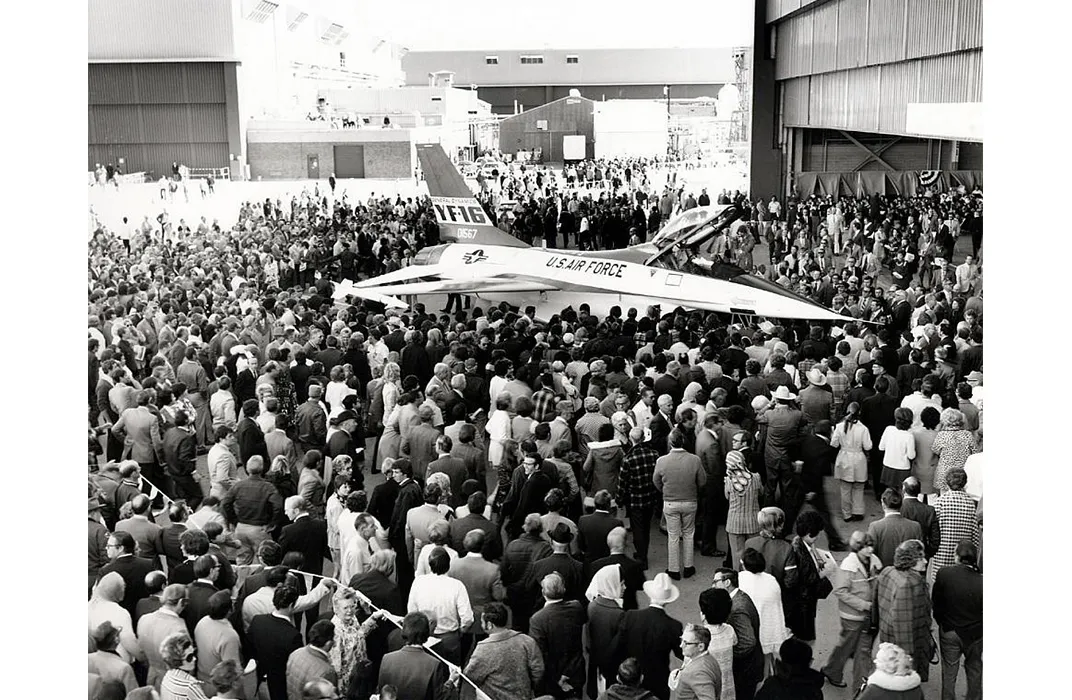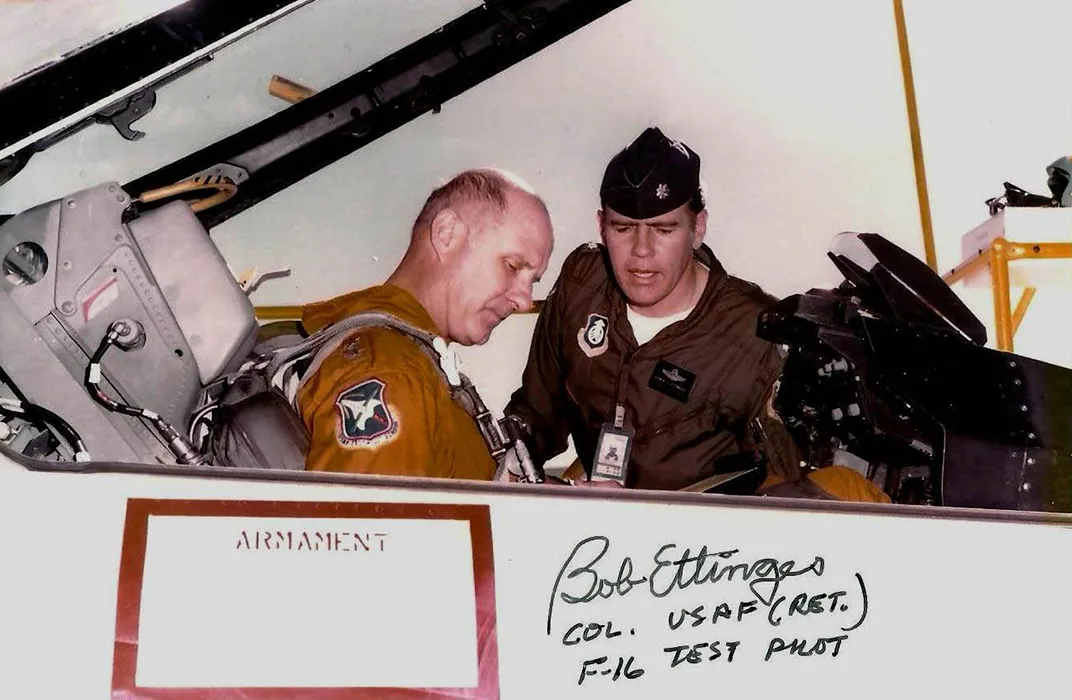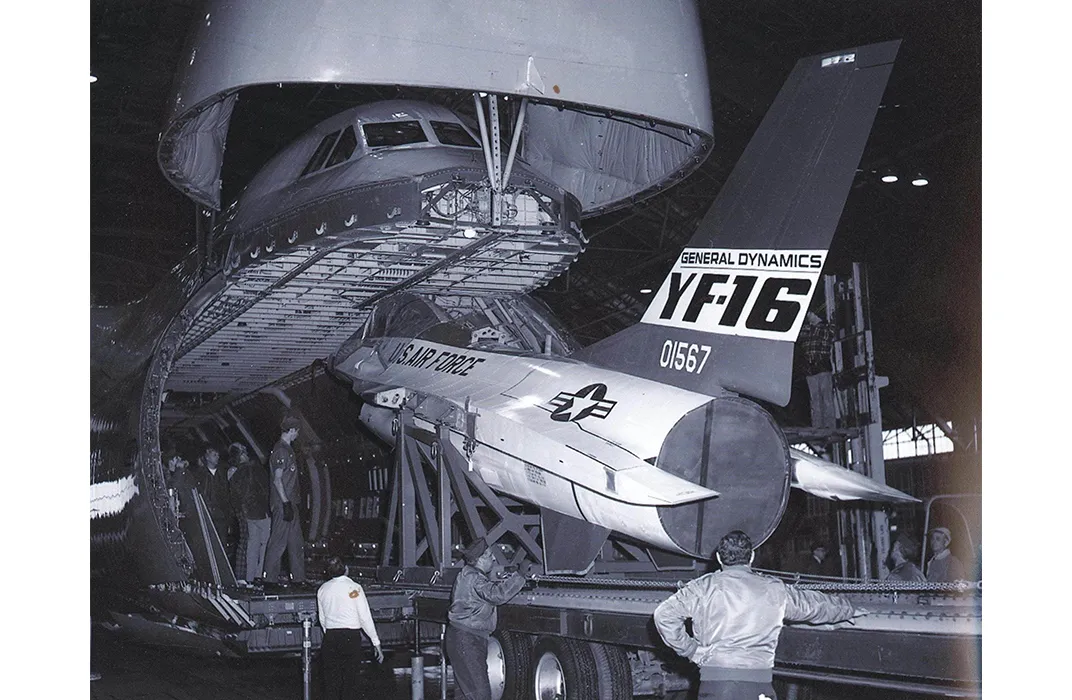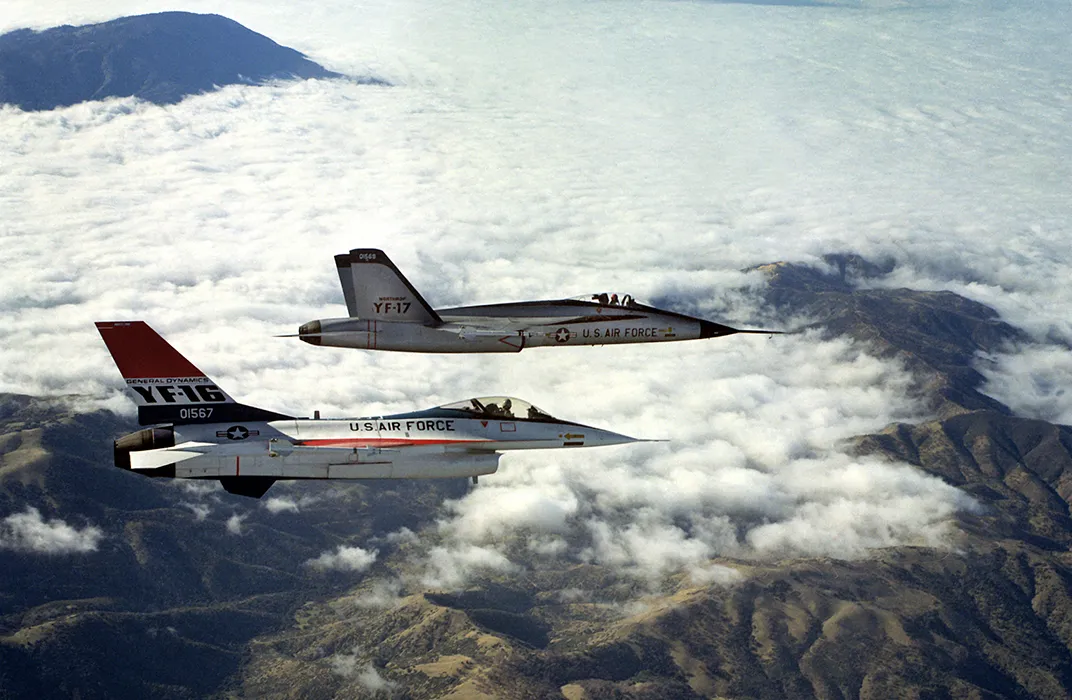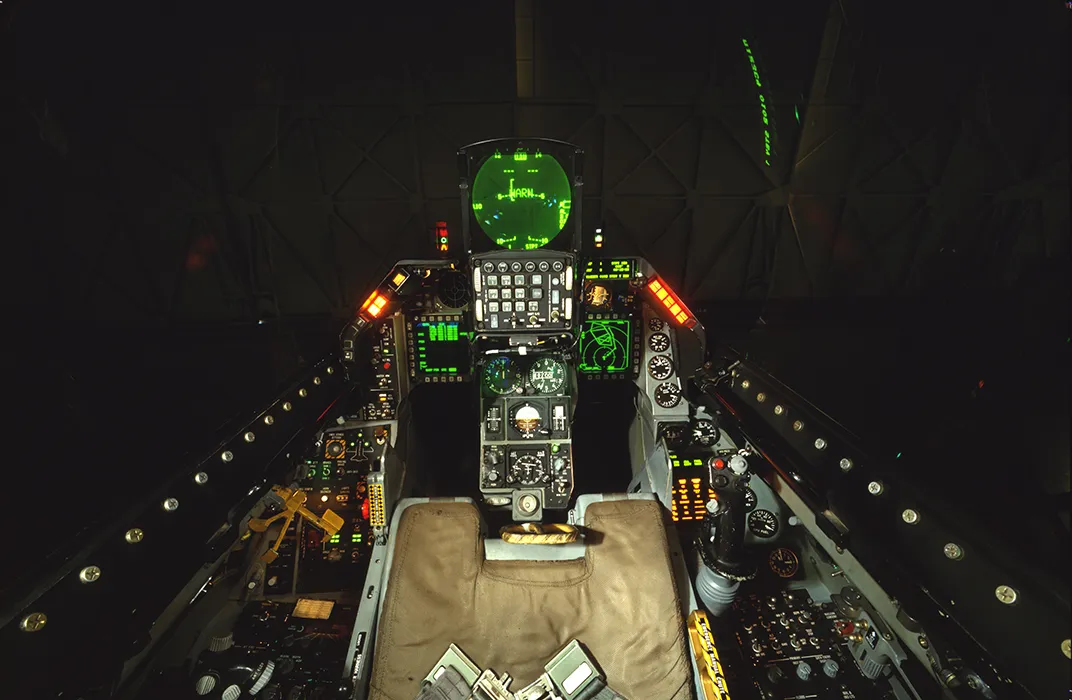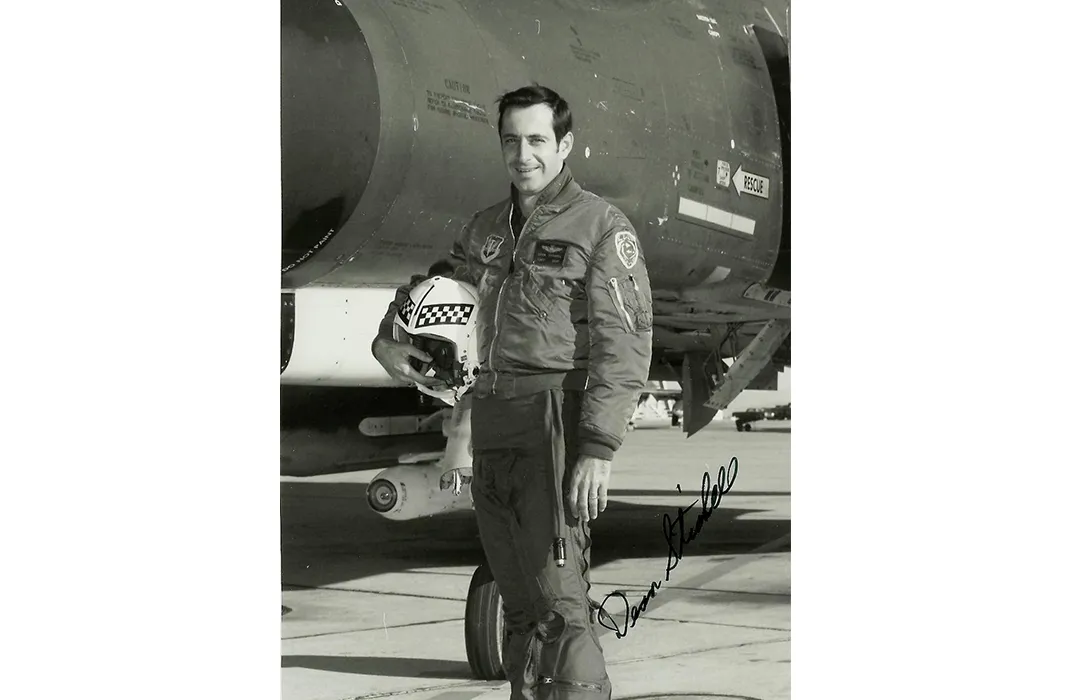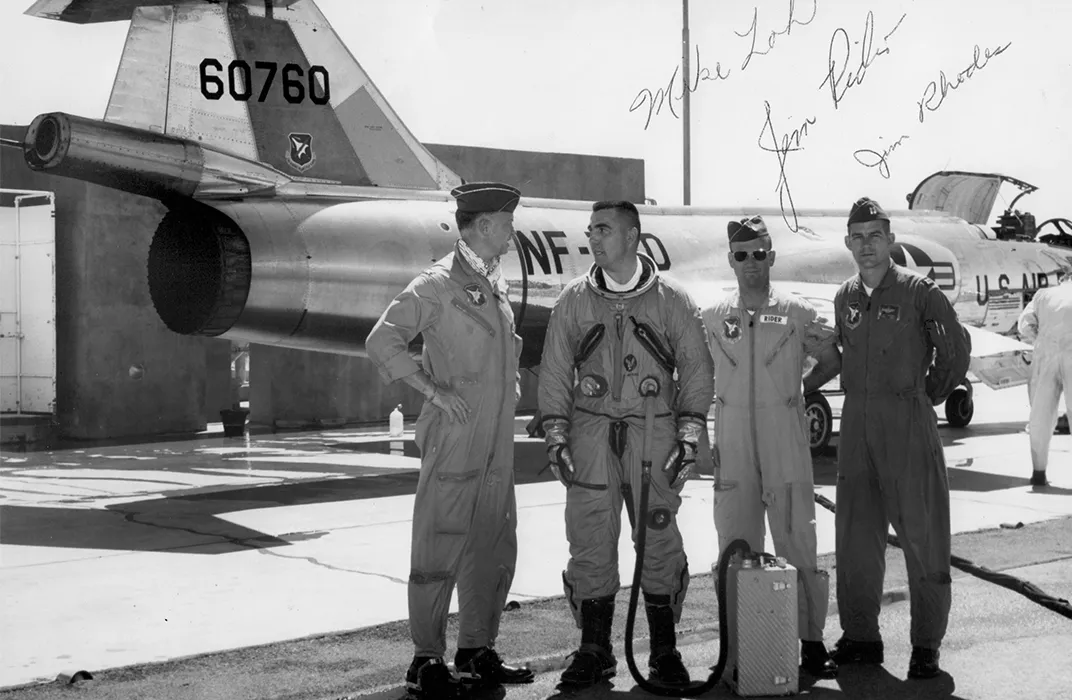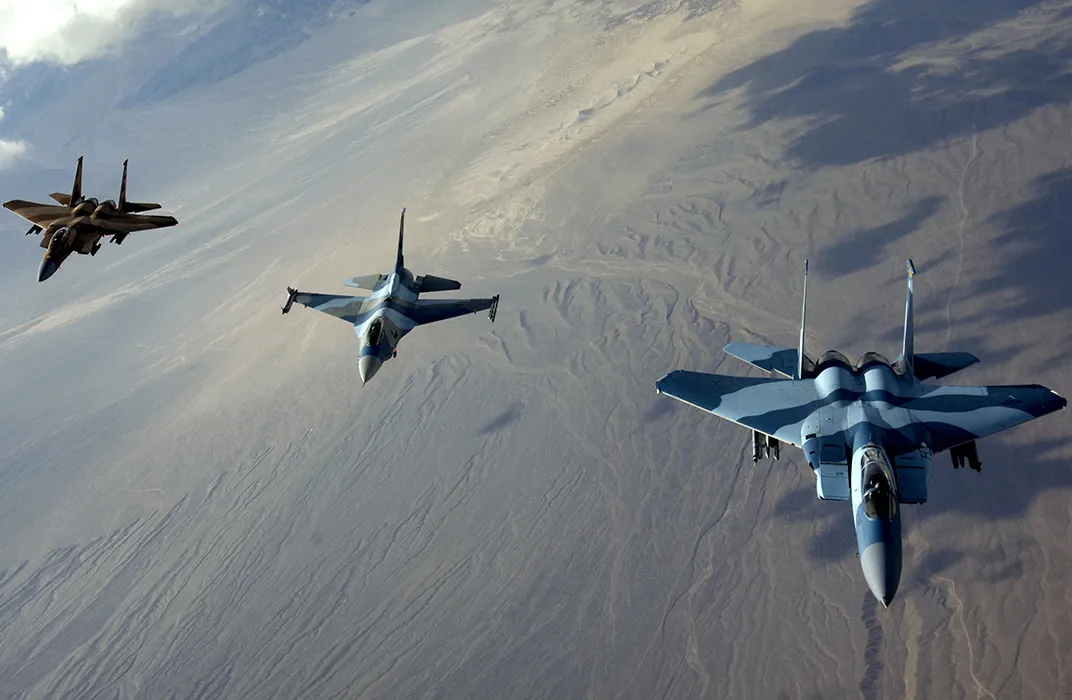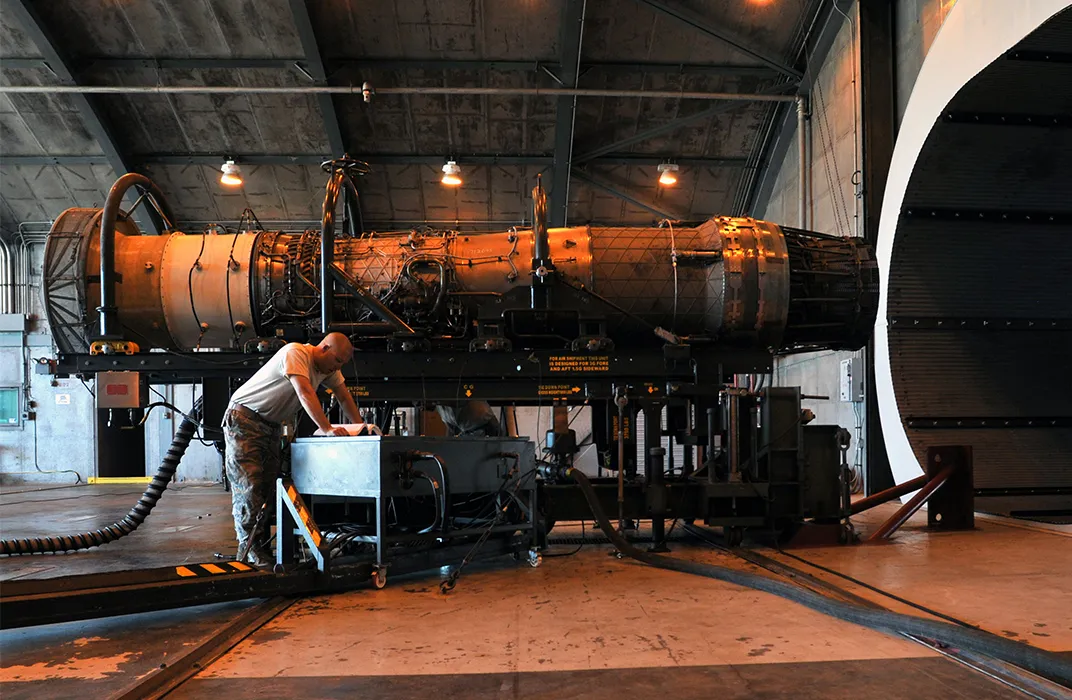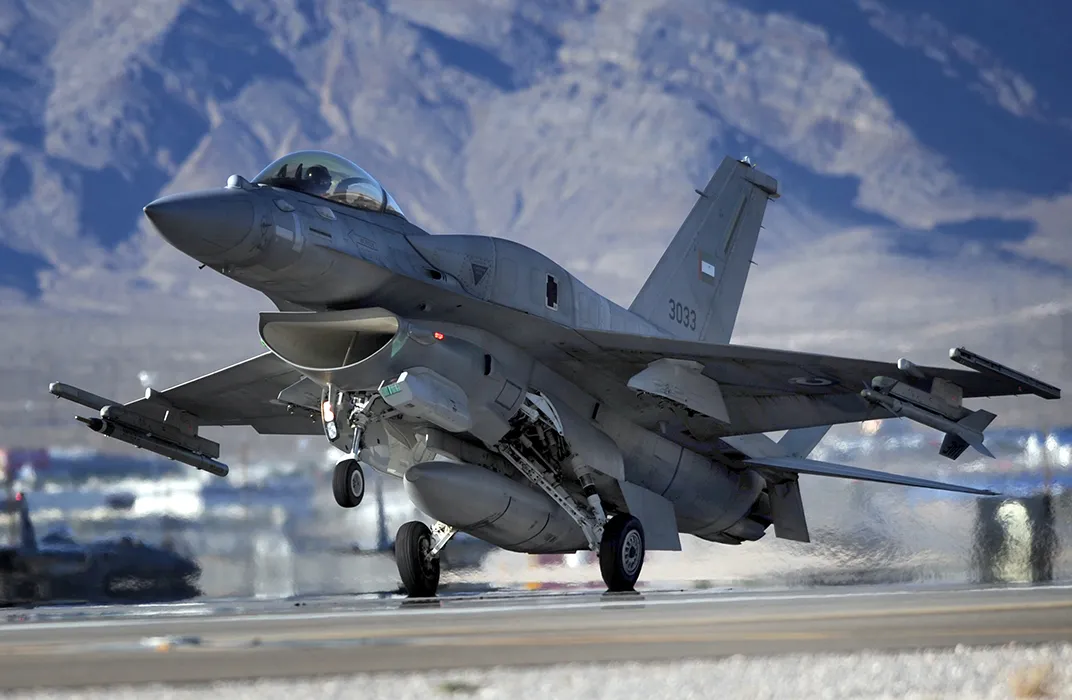Funny Air Force Maintenance Video Can You Go Faster
/https://tf-cmsv2-smithsonianmag-media.s3.amazonaws.com/filer/c6/0d/c60dfdb0-fea8-4a54-af84-146202684bf3/09_f16-the-early-years_feb_14.jpg)
This is the story of two brothers, who happen to be airplanes. The older brother, the F-15 Eagle, entered the world fully formed, and his doting parents—the U.S. Air Force—nurtured him and quickly forgave minor transgressions. The younger brother, the F-16, was born prematurely, with no name, and scrambled to catch up. At a rollout ceremony on December 13, 1973, in Fort Worth, Texas, the YF-16 faced its skeptics and a few champions with a gaudy red, white, and blue paint job. After the ceremony, the airplane was flown on a C-5 to Edwards Air Force Base in California to prepare for its first flight.
On January 20, 1974, during a high-speed taxi test, General Dynamics test pilot Phil Oestricher applied what he thought were small control-stick inputs in the standard method used to check the airplane's roll response. However, in response to the pilot's input, the control stick in the YF-16, mounted on the right instead of the customary center, didn't actually move. Instead, it measured the pressures exerted by the pilot's hand and relayed that data, via electronic sensors, to hydraulic actuators in a newfangled fly-by-wire control system. The simulator Oestricher had flown didn't adequately portray the stick forces, so he hadn't learned to judge how much aileron he was commanding.
Too much, apparently. The YF-16 oscillated wildly, banging the right elevator on the runway. After struggling with the aircraft, Oestricher decided it would be safer to take off. The test director, retired Colonel Jim Rider, remembers being "up in the control tower, watching my career go down the tubes."
The short flight and landing were uneventful, no one got fired, and General Dynamics scheduled the first official flight for February 2. Retired Colonel Bob Ettinger, a YF-16 test pilot, was assigned to investigate the cause of the incident. He concluded that it "resulted from flying an antiquated flight test technique that didn't work for a fly-by-wire system." It would be one of many lessons taught by the new arrival.
One of two entries in the Air Force's Lightweight Fighter (LWF) technology demonstration program (the other was the Northrop YF-17), the YF-16 used Pratt & Whitney F100 engines from the McDonnell Douglas F-15. It picked up existing components from other aircraft, including landing gear tires from a Convair B-58 bomber. What the YF-16 had that was all its own was an unstable, and therefore highly maneuverable, airframe that could withstand 9 Gs and, to manage its fly-by-wire flight control system, four computers, without which the airplane could not have maintained controlled flight. To help pilots cope with the airplane's 9-G capability, the seat reclined 30 degrees, and the side-mounted control stick had a rest to support the pilot's arm when it weighed many times normal. A "hands-on throttle and stick" put all the vital buttons, switches, and toggles at the pilot's fingertips, and also eliminated the need for the Guy In Back.
Although the Air Force expected the F-15 to be a good dogfighter, its primary mission—intercept Soviet MiG-25s—required a bulky radar and a load of medium-range Sparrow missiles, which drove up weight and expense. Appalled by the escalating costs of the C-5 Galaxy heavy lifter and the F-111 swing-wing, multi-role fighter, some advocates in the Pentagon, led in the Air Force by "Mad Major" John Boyd, pushed for an inexpensive, lightweight, highly maneuverable platform that would be used only as a daytime fighter.
Retired General Mike Loh, a fighter requirements staff officer at the Pentagon during the early 1970s, became part of Boyd's "Fighter Mafia," Air Force officers and civilian defense analysts who advocated air-combat maneuverability over heavy—and heavily armed—fighters. Loh, a fighter pilot, test pilot, and self-described "technical guy," first met Boyd in 1965 at Florida's Eglin Air Force Base and became intrigued by his energy maneuverability (EM) theories for comparing fighter performance. In October 1969, after attending the Air Force Test Pilot School and spending a year in Vietnam, Loh requested an assignment to work for Boyd at the Pentagon.
During the day, he worked on modifying existing aircraft. At night, he worked with the team who applied Boyd's EM concepts to determine the overall weight, wing area, and thrust requirements for a lightweight fighter that could gain the upper hand on another jet by turning and climbing faster in a given situation. Loh spent so much time talking to Boyd on the phone in the evenings that he still remembers Boyd's phone number. (Boyd died in 1997.)
Loh says that each Fighter Mafia member had a different agenda. "Boyd was unquestionably the leader and dominated the crusade. His motivation was to vindicate his EM theory, and he wasn't concerned about any mission beyond close-in air-to-air combat. He spent hours debating anyone who challenged his views."
On the other hand, General Dynamics system analyst Pierre Sprey "was a true Luddite, opposed to any advanced technology," says Loh. "His agenda was to produce the cheapest fighter for daytime air combat in Europe against Warsaw Pact forces."
Loh remembers that Pentagon analyst Tom Christie also wanted to validate the energy maneuverability theory, but was more interested in building an affordable fighter to augment the F-15. Loh, the pragmatist, tried to balance the competing personalities so they could actually build a lightweight fighter: "I had to try to channel the agendas away from features that would make the LWF unacceptable to Air Force leadership," he says.
Despite the differences, Loh says, "All of us…were concerned about the cost trend in fighters…where each generation of fighter was going to be 10 times more expensive than the previous generation."
Although the Lightweight Fighter program is often portrayed as an end-run by a highly principled officer (Boyd) around the unwieldy military acquisition system, retired Lieutenant General Glenn Kent points out in his 2008 memoir, Thinking About America's Defense, that "the reality…was more nuanced." With the F-15 alone, the Air Force would not have been able to build the number of airplanes needed in Europe to overcome Warsaw Pact forces. According to Kent, because an all-F-15 force was too expensive, the Air Force finally agreed to look at the LWF primarily as the "low" part of an affordable "high-low" mix of weapons systems.
At the time, Secretary of Defense James R. Schlesinger, an advocate of prototyping programs, approved an Air Force proposal to build two Lightweight Fighter prototypes. At first, although Air Force leaders were willing to let the prototypes fly, they had no plans for production. The F-15 was the only child they wanted.
However, Loh says, "I knew all along the LWF was going to interfere with the F-15."
Air Force Systems Command test pilots and Tactical Air Command pilots flew the YF-16 and YF-17. By all accounts, the -16's performance was phenomenal, but the aircraft had inherited a major problem from the F-15: the F100 engine. Installed on the F-16, it had an alarming habit of refusing to provide more than idle thrust at the worst possible moments. On their first flights, Ettinger and retired Colonel Dean Stickell both experienced engine "rollbacks"; Ettinger didn't even make it out of the chocks, but Stickell's rollback occurred shortly after takeoff. Fortunately, he was at 15,000 feet and right over the runway at Edwards. The engine was also prone to compressor stalls, a phenomenon that can produce spectacular flames out both ends of the engine, with explosions violent enough to knock a pilot's feet off the rudder pedals. Until the engine problem was fixed, the YF-16 had to stay within deadstick landing distance of the base.
Eventually, both the YF-16 and YF-17 passed their tests. At least in part because of NATO interest in the airplane, Schlesinger persuaded the Air Force to buy the Lightweight Fighter "winner." In return, he would let the Air Force buy all the F-15s it had originally wanted and would increase the number of Air Force wings, with the caveat that the new wings be equipped with LWFs.
In agility, acceleration, and turn rate, the YF-16 dominated the YF-17 above transonic speeds. In addition, the single-engine YF-16 also had a huge advantage in fuel consumption, and the airplane afforded the pilot increased G-tolerance and better visibility. Still, the newcomer had no mission of its own. The Air Force might assign it to supplement its fighters—the F-15 and F-4—or its ground attackers—the F-111 and A-10—in their primary roles.
In June 1972, the Air Force had sent Loh to the Massachusetts Institute of Technology for a master's degree in aeronautical engineering and assigned him to the prototype office at Wright-Patterson Air Force Base in Ohio to manage the budget, contracts, and overall engineering for the Lightweight Fighter. When the F-16 was selected, the Air Force formed a system program office at Wright-Patterson, where Loh signed on as director of projects, with the responsibility to integrate the avionics and weapons systems on the airplane. But he was in a quandary. Air Force four-star generals had ordered him not to put a Sparrow missile on the F-16 because they didn't want it competing directly with the F-15. But they didn't say anything about inventing a new missile.
"I pursued a lightweight radar missile very quietly, as an advanced development project, with no strings to the F-16 or any other fighter," Loh says. "I worked quietly with missile contractors and the Air Force Development Test Center at Eglin to put together radar missile designs that could fit on Sidewinder stations. This initiative later turned into AMRAAM, the Advanced Medium-Range Air-to-Air Missile."
Loh wanted the F-16 to be a fighter that was good at both air-to-air and air-to-ground missions, but he also needed to keep the weight down. From 1975 to 1978, he worked on a configuration steering group, led by Major General Alton Slay, dedicated to deciding what systems would go on the F-16. "Its goal was very simple," Loh says of the group. "Just say 'no.' "
Saying no kept the weight down, but people began complaining that the jet would never be useful, so Loh finally revealed his incubating missile. Slay and Loh also believed that eventually many other systems would fit, since the trend toward miniaturization had been leading to smaller weapons and lighter equipment.
When Slay's group started its work, the F-16 and F-15 communities began to develop a rivalry, in part because of different management styles. Determined to avoid cost overruns, the F-15 program manager, then-Major General Benjamin Bellis, bypassed normal reporting chains and ran the program like it was classified. Although retired Colonel Wendell Shawler, director of the F-15 joint test force in the early 1970s, recalls giving YF-16 pilots flights in F-15s to demo the F100 engine, he otherwise hardly saw them. Ettinger remembers, "F-15 management didn't want strangers sitting in the cockpit, making suggestions to change things."
F-16 management, on the other hand, embraced change. The advanced technology drove an open environment, and pilots, engineers, and maintenance personnel reported every minor problem or idea that cropped up in testing. According to Ettinger, "We let everyone in the world sit in the F-16 cockpit." Even Prince Charles, who visited Edwards in October 1977 to watch the final glide test of the space shuttle demonstrator Enterprise.
In 1980, retired Major General Larry "Snake" Wells, then a lieutenant, was a pilot in the first F-16 class at Hill Air Force Base in Utah, with other lieutenants fresh from pilot training. He remembers learning radar intercepts in the back seat of an F-4 simulator. Instead of the standard flight manual, most information about the jet was in a set of self-paced training notebooks of dubious value. Pilots made things up as they went along, and one pilot attempted to design a short-field landing technique by touching down while applying the brakes, with predictable results: an 800-foot landing roll accompanied by cherry-red brakes, black smoke, and flames shooting from beneath the jet. Where most aircraft might see a handful of procedural changes during a year, the F-16 often racked up at least one change per week, and sometimes the change reverted to the original procedure a few weeks later.
In spite of the churn, "the F-16 was awesome," says retired Lieutenant Colonel John Armor. He transitioned from flying the F-4, which had such a poor cooling system that if pilots closed the canopy while on the ground, they were immediately drenched in sweat. Armor says of the F-16, "Number one was the air conditioning worked on the ground."
Every pilot I interviewed for this story mentioned how much fun the airplane was to fly: It had easy handling qualities, the bubble canopy afforded unimpeded visibility, and the head-up display, in which the airplane's vital statistics are shown on the windshield, improved awareness. Stickell, an instructor pilot at Hill after the test program, remembers how easy it was to teach even beginning pilots to fly air-to-ground missions. What took months of practice in the F-100 could be learned in three flights in the F-16. However, some transitioning pilots complained about landings. F-4 pilots were used to flying a "controlled crash," which kept the heavy airplane firmly planted on the runway, but the F-16's light weight and wimpy brakes led to bouncy landings, mangled tires, and unhappy crew chiefs. Other pilots had problems with the early airplanes' fixed sidesticks. Later incarnations allowed some minor stick movement as a sort of psychological fix.
Even with the openness of F-16 management and test flights conducted by both test pilots and operational pilots, the test program didn't uncover all the jet's problems. In the early 1980s, several pilots died when they flew into the ground because of electrical problems with the flight control system—precisely the kind of accident some people feared would happen in an aircraft so unstable that it relied on its electrical systems to fly. The fix provided emergency backup power from the aircraft battery as well as protecting the flight control computers from voltage surges.
Such a revolutionary fighter presented other hazards. Although G-suits were improved to react faster, the rapid onset of G forces could cause a pilot to black out before he even knew what was happening. Tactical Air Command beefed up centrifuge training to help pilots avoid loss of consciousness due to high G loads.
Everyone agreed the F-16, like many younger brothers, was fun to have around, although many believed he would never earn an honest living. In 1980, the F-16 still didn't have an official name. Pilots had dubbed the jet the "Viper" after the fighter spacecraft in the TV series "Battlestar Galactica." Many pilots wore "Viper Pilot" name tags. Leadership demanded the pilots remove the tags, but the unofficial nickname stuck. Most everyone can agree it was far better than the aircraft's eventual official name, Fighting Falcon, which could be the name of your middle school football team.
The reality of the F-16 didn't quite meet the expectation for some pilots, especially those who transitioned from the lumbering F-111 fighter-bomber. Retired Lieutenant Colonel Dana Purifoy, part of the initial F-16 cadre at Hahn Air Base in Germany, remembers his surprise at doing more air-to-ground work than air-to-air. In addition, to F-111 pilots flying air-to-ground missions in Europe, the F-16 seemed like a giant step backward. Purifoy says, "I thought I'd traded one bad deal with an airplane I thought had at least some possibility of survival [when battling Warsaw Pact forces] for an airplane I thought had zero possibility of survival." In the F-111, Purifoy enjoyed an all-weather radar and automated terrain-following system that enabled him to fly a mere 200 feet above the ground. The early F-16 was more like a Cessna 172, with a basic instrument landing system and no radar altimeter.
Before long, pilots who flew the F-15 taunted F-16 crews about their scrappy airplane, but Viper pilots knew what the jet could do, especially when dropping bombs. Visual bombing was so accurate that Ettinger says the test pilots called the pipper on the head-up display the "death dot." In June 1981, during a precision bombing competition against F-111s, SEPECAT Jaguars, and Blackburn Buccaneers at the Royal Air Force Lossiemouth base in Scotland, the F-16 destroyed all ground targets, recorded 88 air-to-air kills, and had no losses while achieving a near-perfect score.
By the early 1980s, improvement programs began to materialize. The most important was LANTIRN, Low Altitude Navigation and Targeting Infrared for Night. In addition to turning "night into day" and providing low-altitude terrain-following guidance, LANTIRN promised to improve the F-16's rudimentary precision-guided weapons capability. Retired Colonel Dave Martin, an early LANTIRN test pilot, says the forward-looking infrared technology was so good that when they later added night vision goggles, the goggles just added weight without any real benefit. He recalls that on his first flight he had a hard time trusting the terrain-following guidance, but his instructor coaxed him down to 200 feet while screeching along at almost 575 mph. "That was the first time I'd imagined doing something like that in an airplane at night," he says. "After some practice, it just became second nature."
But full LANTIRN capability wasn't available to the F-16 during Operation Desert Storm in 1991. The few production pods that existed went to the more-capable F-15E strike aircraft. Without the LANTIRN targeting pods, F-16 pilots mostly dropped unguided weapons from high altitudes, resulting in many targets being missed. In addition to demonstrating the need for more precision-guided weapons, the Gulf War showed the ascendancy of the radar missile—29 of the confirmed or probable 44 air-to-air kills (none by F-16s) were made by Sparrows. Some felt the F-16's performance in the war was marginal—a few F-4G Wild Weasel aircrew, charged with destroying enemy surface-to-air-missile sites, suggested the Viper be stamped "For training use only."
As the F-16 approaches middle age, the "supplemental airplane" has become a multi-role rock star for 26 countries. More than 4,500 Vipers have been built. Within a few months after the Gulf War, F-16s began receiving many of the planned upgrades, including the long-coveted LANTIRN pods and the AMRAAM radar missile. On December 27, 1992, an F-16 patrolling the post-war Iraqi no-fly zone shot down a MiG-25 with the first-ever air-to-air kill for both an F-16 and an AMRAAM.
Throughout the 1990s, the airplane continued to improve, despite a last-ditch attempt by the F-4G Wild Weasel community to keep the SAM-site killing mission for themselves. The current F-16 Block 50/52 Wild Weasel capabilities include an improved radar, suppression of enemy defenses, and even a missile for destroying ships. The spunky little brother finally grew up.
pasleymonexte1974.blogspot.com
Source: https://www.smithsonianmag.com/air-space-magazine/outrageous-adolescence-f-16-180949491/
